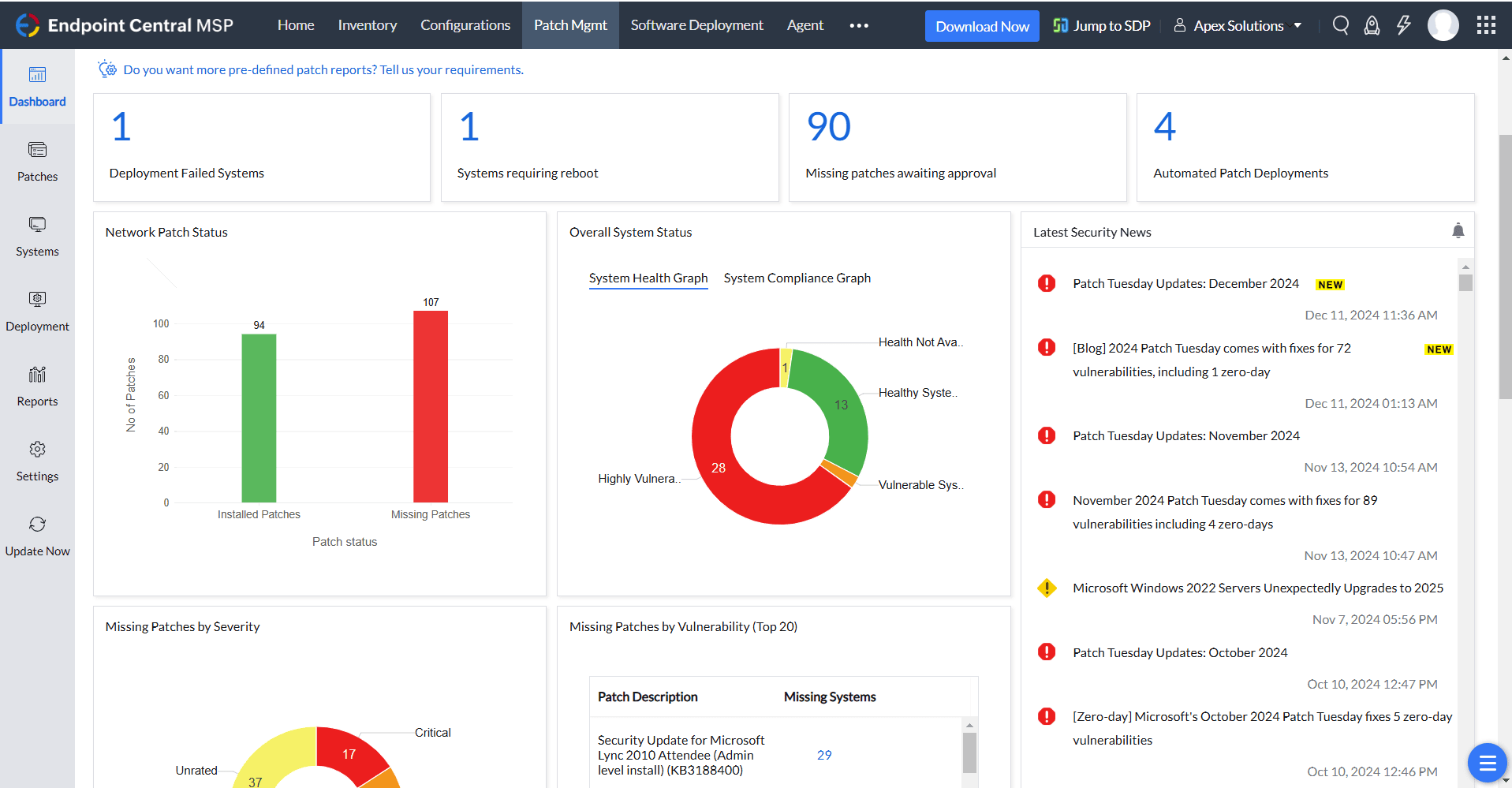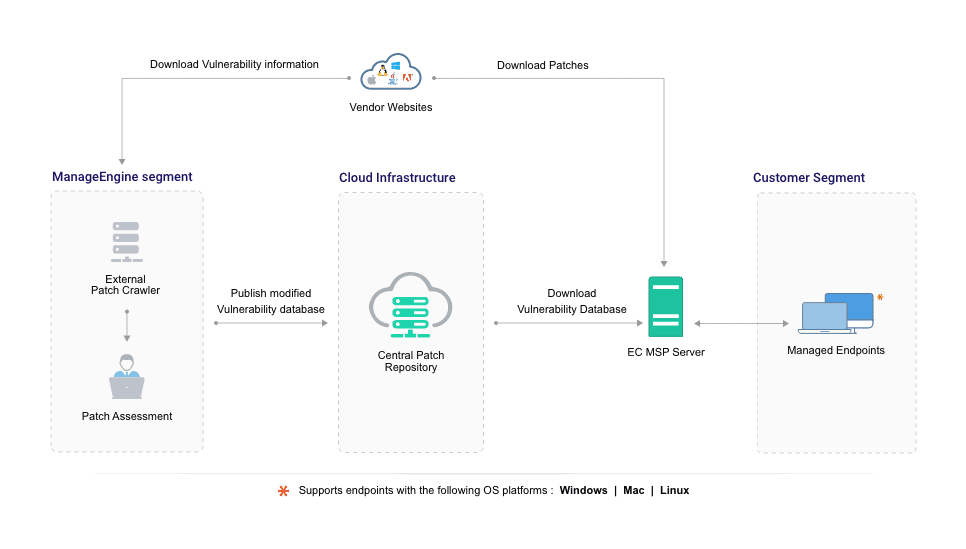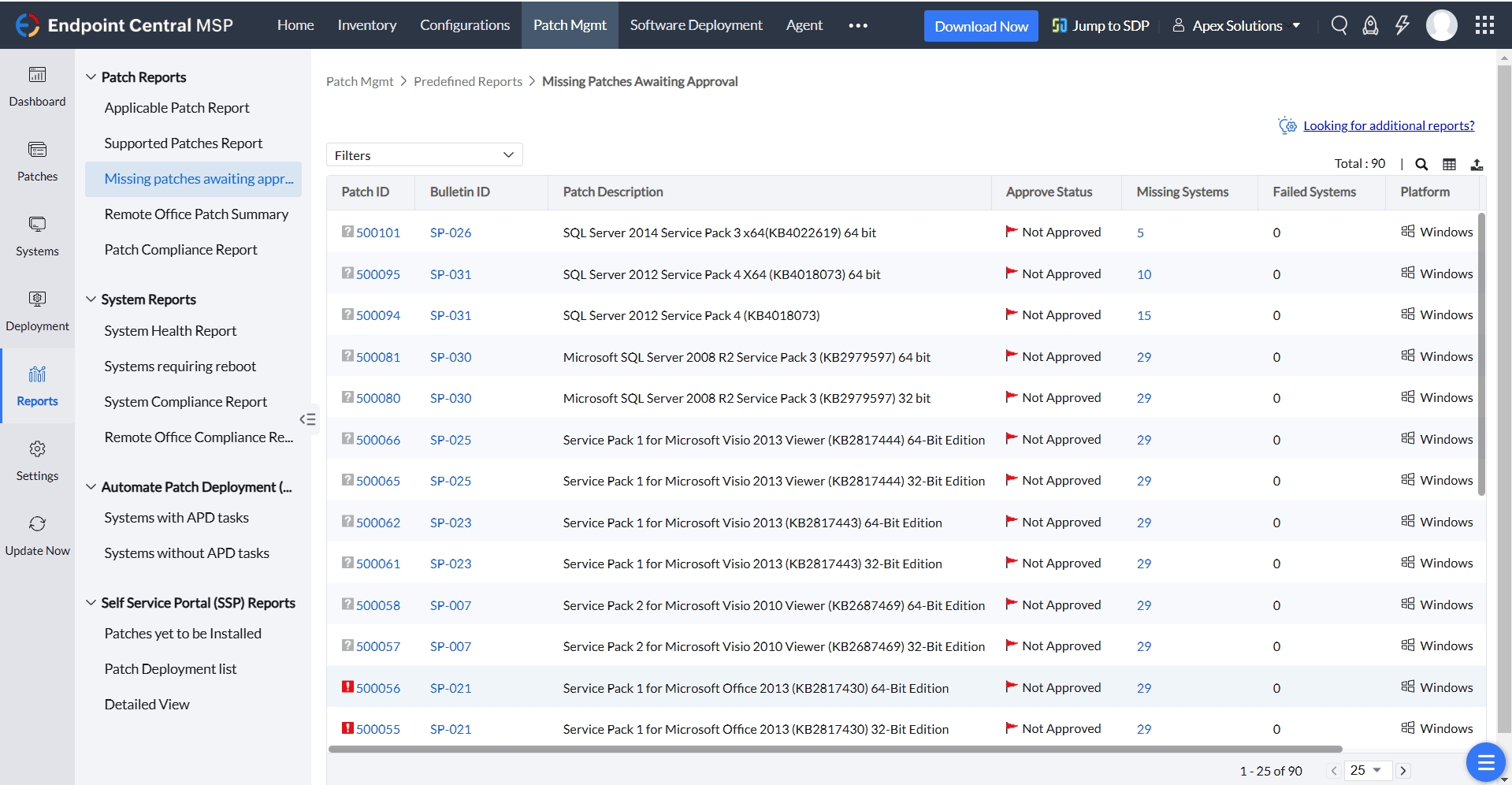Proactive patch management and software updates are crucial for safeguarding your clients' IT environments and optimizing system performance. As your client base grows, so does the complexity of managing these systems, making efficient and reliable solutions even more essential.
Endpoint Central MSP simplifies your patch management process by automating updates for Windows, Mac, Linux, and a wide range of third-party applications (view the complete list here ). With granular control over deployment schedules and policies, you can improve efficiency and enhance the security of your clients' systems.
Patch management dashboard

Updated vulnerability database
Zoho Corp. continuously probes the internet for newly released patches and vulnerabilities. Once a new patch is discovered, it is added to Zoho Corp.'s central patch repository after ample verification and testing. This repository can be accessed by the Endpoint Central MSP server and is used to evaluate vulnerabilities within clients' networks.
Updated vulnerability database

On the client's site, the server maintains a vulnerability database which is synced periodically with the central patch repository. This sync is done in two ways:
- Daily sync: The server syncs its vulnerability database with the central patch repository every day. You can configure the time at which this sync will take place.
- On-demand Sync: The vulnerability database can be updated anytime by initiating an on-demand sync.
Automated patch deployment
Endpoint Central MSP ensures your clients always have the latest versions of their favorite third-party applications by automating daily downloads. This streamlined process saves you time and resources, allowing you to schedule automatic patch deployment for specific applications or departments at your client's preferred time and frequency. With a single setup, you can automate the entire process and receive notifications at each step. Visit this webpage to learn more.
Test and approve patches before deployment
Deploying untested patches in a production environment can be risky, as some patches and updates may introduce compatibility issues or other post-deployment problems. To mitigate this risk, it's recommended to test patches on a selected group of systems before rolling them out to the entire network. By automating the patch installation process on these test systems and setting automated approval timelines, you can ensure a smooth and reliable patch deployment process, minimizing downtime and maximizing security for your client's network.
Client-centric deployment policies
Ensuring network patch compliance while keeping technician productivity unbothered is simpler than ever with flexible patch deployment policies. By configuring deployment policies, end users can schedule reboots at their convenience, minimizing disruptions to business-critical tasks. Additionally, there are granular functionalities like targeted deployment on specific days, weeks, or time intervals coupled with customizable pre- and post-deployment activities, catering to diverse client needs.
Third-party patch management
Endpoint Central MSP extends beyond operating systems, offering comprehensive patch management for over 850 third-party applications, including the latest releases. This broad coverage enables you to test and deploy patches to a wide range of applications, ensuring optimal security and performance for your clients' systems.
Disable patches
You can choose to decline patches for certain applications (legacy applications) or in case there's a patch that causes instability when it's installed on test systems. Endpoint Central MSP allows you to decline non-severe patches as well as patches for a specific group of computers.
Periodic patch scanning
A patch scan is automatically initiated every time the vulnerability database is updated. All systems in your clients' networks will be scanned for missing patches within the next 90 minutes, and this data will be posted to the server.
System health policy
Endpoint Central MSP allows you to classify the health status of the systems within your clients' networks via the system health policy. You can specify the number of missing patches that indicate if the systems should be classified as healthy, vulnerable, or highly vulnerable. Based on this classification, you will be able to narrow down the systems that need immediate attention and take effective measures.
Automate antivirus updates
Endpoint Central MSP also helps automate antivirus definition updates. Such updates are quite frequent and may happen several times a day, which might result in high bandwidth consumption. By scheduling these updates at your clients' convenience, you can optimize bandwidth usage and minimize disruptions to their operations.
Disable automatic updates
You can disable automatic updates in just a few clicks. This allows you to have complete control over any updates that are installed within your clients' networks.
Reports
After successful patch deployments, reports are automatically generated and the information is sent to the server. Reports can be easily customized to filter data, and results can be downloaded and shared in multiple formats.
Patch Management Reports

Patch management using the mobile app
You can manage patches on the go with our mobile app. In just a few taps, you can install software patches, approve or decline patches, view detailed patch reports, initiate patch scanning, and much more! What's better is that you don't even have to do these tasks yourself; just ask Zia, Endpoint Central MSP's IT assistant, and it will do them for you.
Master streamlined client management workflow. Learn more on Account Management.

"The central hub of management is the best part with Endpoint Central MSP. I don't have to jump around to various different servers and software pieces to achieve what I can achieve in one place. Love the dashboards and simplicity of being able to visually see what I'm looking for without having to investigate every time. Love the support and that I can always get dedicated service whenever I need it. From actual people, that's the most important part."
- Donny H,
Systems administrator.